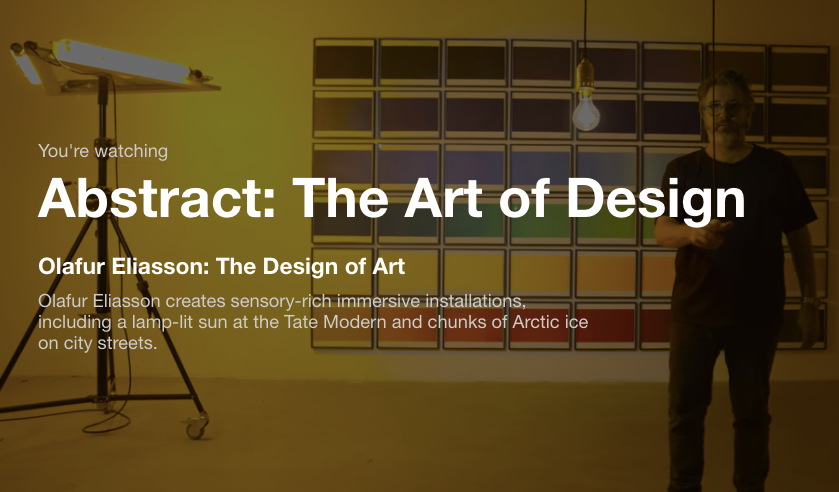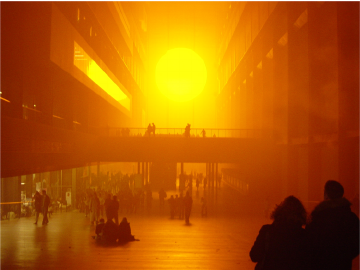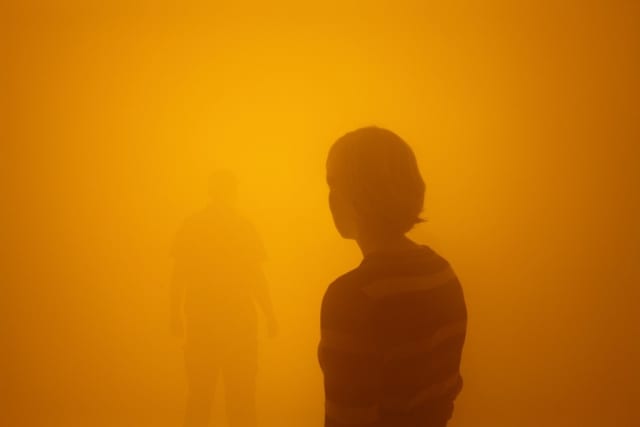OLAFUR ELIASSON: THE DESIGN OF ART

Musings on a Netflix special...
Art as experience.
This is the core principle that underpins the work of Icelandic-Danish designer Olafur Eliasson as well as the primary theme in his eponymous episode of Netflix’s “Abstract: The Art of Design” series. He talks to and experiments constantly with the camera, literally opening the episode with ‘I would like to design an experiment with you, and that means you and I are going to collaborate’. His artwork always encourages interaction and forces the viewer to experience the work actively rather than observing passively. In Eliasson’s own words, ‘You are a co-author with me… what you see is up to you and this is the philosophy that makes him one of my favourite artists. I've been lucky enough to experience some of Eliasson’s works at the Tate Modern and this really does translate; you, the viewer, really do become a collaborator in the creation of the art and it’s meaning.

‘The Weather Project’ - 2003
For those who don’t know Eliasson’s work it’s epitomised by one of his most famous pieces, ‘The Weather Project’. This large scale installation piece turned the already colossal space of the Tate Modern’s turbine hall into a dense, foggy space baked in the monochromatic yellow light produced by an enormous ‘sun’ and mirrored ceiling. For the period this was installed - in which I was lucky enough to visit but most definitely not remember - the public did yoga, sunbathed, meditated and more in the space, each person interacting with and experiencing the piece in their own way.
Light and space are Eliasson’s primary medium. Some of his other works I’ve experienced in the past include
‘Din Blinde Passager’ or ‘Big bang fountain’, both installations using light and its interaction with the surrounding environment to create artwork that is fully dependant on the viewer’s perception to even materialise. The viewer is always invited to interact with the work, and through this create their own meaning of the experience.

‘Din Blinde Passager’ - 2010

‘Beauty’ - 1993
The aforementioned Netflix episode, ‘Olafur Eliasson: The Design of Art’, does well to portray the intentions behind Eliasson’s work in a way that a gallery space struggles to do so explicitly. Speaking in the episode on one of his earlier works, ‘Beauty’, Eliasson says, 'My work is completely dependant on the spectator turning ideas into art… When you leave the exhibition and there is no one in the room, there is also no art'. People are allowed to perceive the art in different ways and experience different emotions, personal to themselves as opposed to than the artist. The time taken to collaborate with the piece and the thoughts and feelings stirred by it are what constitute the art and its meaning.
And nowhere is this more relevant than in my ongoing 'Retail Therapy' project, where I'm designing
a kaleidoscope and currently find myself stuck in the hole of defining the who and the why. I’m not making this to be a product people display and treat as a classical piece of art, I want it to be an experience and to create its own meaning to the user. I want people to consider how the product makes them feel and how they interact with it; to take a minute and look at the world through another potentially more mindful lens. Maybe doing this stirs a breakthrough, maybe it helps focus the mind, maybe something is reconsidered
and you look at the world around you in a new way. Whatever the product does,
it’s personal to the user and not defined prior to use.

‘Big Band Fountain’ - 2014

‘Room for One Colour’ - 1997
A more technical question lingering over my project was of the many types of kaleidoscope which I wanted to create. For example, a teleidoscope, which does away with the colourful gems used in a normal kaleidoscope and instead allows the user to see the world around them through the lenses and mirrors held inside.
Before ‘The Weather Project’, Eliasson created ‘Room for One Colour’ using the monochromatic yellow
light to suck the colour from the exhibition space. When asked by the exhibition director to place an object, even just a rose, in the centre of the room to illustrate the absence of colour he responded ‘No, because then the show is about a red rose’. This interaction and experience is something I want to carry through to my product. As nice as it is, I don’t just want to create pretty geometric patterns for the user to observe. I want to create something that allows for a more individual experience, something that can be viewed and used
in a multitude of ways, something that makes the user consider the space around them,
not the rose in front of them.
I’m realising now that this blog may just be becoming a design journal and you’re getting dragged along for the ride. I'm seeing themes in my interests and posts that are presenting themselves in the products I’m designing; maybe thinking about design is making me a better designer.
Who would’ve thought it…

.....
COMMENTS:
To leave a comment, email your comment to jakabon@outlook.com with the title
of the post you wish to comment under as the email subject
Joey Morris
I loved the weather project! I went 3 times. Just lay down and relaxed under the sun... but was really communal. I like the idea of what you see is up to, and collaboration in the artwork.
8th Feb
